Boston and Bharat
In the late 1700s and early 1800s, ships from Boston and nearby Salem used to sail up and down the Atlantic, mostly with Ice blocks. These were preserved using saw-dusts and missionaries went to preach to the ‘heathens’ of Bharat, that is India. In those hay days of British colonialism, many exotic items including tea, spices, and artifacts filled the ships in the return journey.
The city of Boston and the surroundings in the state of Massachusetts have much historical imprints both for the Americans and the Indians. First of all, the American Revolution took birth here. The Boston Tea Party was formed here after dumping tea from India into the Boston Harbor.
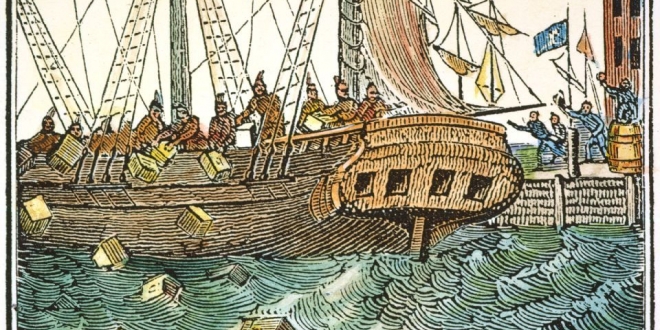
The Suffolk Resolves House in nearby Milton hosted the first meeting of the Tea Party. Many decisive battles took place in surrounding areas including the picturesque cities of Concord and Lexington.

The city of Lowell, not far from Boston, has been the birthplace of the American Industrial revolution.

And the city of Cambridge hosts two world’s premiere universities – Harvard (1636) and Massachusetts Institute of Technology (MIT – 1861). As a matter of fact, this is the capital of American education.
Metro Boston has 8 universities and about 50 colleges with over 400,000 students from all over the world. It is hard to get the actual numbers but one can easily say that among the 50,000+ foreign students, 10% or 5000 would be Indians. Rough estimate suggests that there are close to 200 professors and researchers of Indian origin and at least a couple of thousand US born Indian origin students enrolled in these colleges.
Numerous Indian organizations celebrate many Indian festivals mostly in private settings, and in the temples. There are 15 Hindu Temples (including Baps Swaminaryan and Chinmaya Mission), 2 Jain and 2 Sikh Gurudwaras in Boston area.
Groups celebrate India’s republic day and Independence Day with public events. And that is in present day!
Let us travel back to history for a moment. There came in one of the ships a copy of Bhagavat Geeta which sowed the seeds in the minds of some most influential Americans who started the ‘transcendental movement’. It was Ralph Waldo Emerson who was a son of a minister at a Unitarian Church in Boston area.

He mentored Henry David Thoreau who became a co-transcendentalist. Emerson was introduced to Hindu literature by his aunt, Mary Moody Emerson. Around the 1830’s and then he published excerpts from “Ethical Scriptures” in the transcendentalist journal ‘The Dial’.
Emerson joyously expressed: “I owed a magnificent day to the Bhagavad-gita. It was the first of books; it was as if an empire spoke to us, nothing small or unworthy, but large, serene, consistent, the voice of an old intelligence which in another age and climate had pondered and thus disposed of the same questions which exercise us.”

And Thoreau described how his life was guided by the supreme spirit: “In the morning, I bathe my intellect in the stupendous and cosmogonal philosophy of the Bhagvat-Geeta . . . in comparison with which our modern world and its literature seem puny and trivial.”
During winter, next to his hermitage near the famous Walden pond he marveled: “I lay down the book and go to my well for water, and lo! There I meet the servant of the Brahmin, priest of Brahma and Vishnu and Indra, who still sits in his temple on the Ganges reading the Vedas, or dwells at the root of a tree with his crust and water jug. I meet his servant come to draw water for his master, and our buckets as it were great together in the same well. The pure Walden water is mingled with the sacred water of the Ganges.”

Almost half a century later, a new revolution started in America, this time this is an inner revolution, the spiritual one which was infused in by several prominent people from India either started their journey from Boston or was supported by people here for their success. Why Boston? Perhaps due the fact – it is the hub education – ‘pithasthal‘!
Swami Vivekananda came to Boston on August 25, 1893 and couple of days later gave his life’s very first public speech in any language at the Annisquam Village Church which is still intact.

This happened after he met Professor John Henry Wright of Harvard University there who wrote the famous introduction letter for him to attend the World Parliament of the Religions in Chicago as part of the Columbian Exposition. He wrote about Swamiji: “..is more learned than all our learned professors put together” and noted on another occasion: “To ask for your credentials is like asking the sun to state its right to shine in the heavens.”
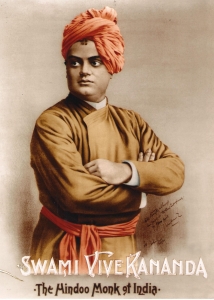
Ironically, on September 11, 1893 he spoke in Chicago: “..Sectarianism, bigotry, and its horrible descendant, fanaticism, have long possessed this beautiful earth. They have filled the earth with violence, drenched it often and often with human blood, destroyed civilization and sent whole nations to despair. Had it not been for these horrible demons, human society would be far more advanced than it is now. But their time is come; and I fervently hope that the bell that tolled this morning in honor of this convention may be the death-knell of all fanaticism, of all persecutions with the sword or with the pen, and of all uncharitable feelings between persons wending their way to the same goal.”
He came to Boston many times in the two years after the Parliament. He spoke at various places in Boston area including the Methodist church in Lynn, at the North Shore Club, at Radcliffe College, and at the Procopeia Club. He lectured twice at Harvard, in May of 1894 at Sever Hall on Vedanta and in 1896 to the Harvard Philosophical Society. Many years later, Miss Ellen Waldo a relative of Emerson helped writing the translation of the Patanjali Yoga Sutra Dictated by Swami Vivekananda.
In 1976, on the occasion of the American Bicentennial, the National Portrait Gallery in Washington D.C., mounted a large portrait of Swami Vivekananda as part of its exhibition “Abroad in America: Visitors to the New Nation,” which paid tribute to the great personalities who visited America from abroad who came to America from abroad during the past 200 years and made a deep impression on the American mind. The commemorative volume of the exhibition says: “The Swami .. left an indelible mark on America’s spiritual development.”
The Vedanta Society on Deerfield road in Boston was established in 1941.
Fast forward a quarter of a century.
One E.E. Dickinson opened a Christmas gift from an Indian Guru and said to have a vision of another Indian guru whom he met many years back and could not believe his eyes and could not even speak overwhelmed with the experiences. The gift was a silver cup from India. He exclaimed and told the Guru – “For forty-three years I have been waiting for that silver cup! It is a long story, one I have kept hidden within me.” Dickinson met with Swami Vivekananda in Chicago at the age of 17 along with her mother.
He further said: “.. After he had given a soul-stirring talk, I went forward to meet him. He smiled on me graciously, as though we were old friends. I was so young that I did not know how to give expression to my feelings, but in my heart I was hoping that he would offer to be my teacher. He read my thought.
“‘No, my son, I am not your guru.’ Vivekananda gazed with his beautiful, piercing eyes deep into my own. ‘Your teacher will come later. He will give you a silver cup.’ After a little pause, he added, smiling, ‘He will pour out to you more blessings than you are now able to hold.’

The Guru of Dickinson was none other than Pramahansha Yogananda. He arrived in Boston in September 1920, as India’s delegate to the International Congress of Religious Liberals. He taught his meditation techniques to hundreds of people from Boston area and lived in nearby town of Somerville till 1964. He later established the international headquarters of the Self-Realization Fellowship in Los Angeles, California. Many famous people became his followers including Clara Langhorne Clemens Samossoud, the only surviving child of Mark Twain.
The Beatles were heavily influenced by one Indian spiritual teacher. In recent times, Dr. Deepak Chopra has become very well-known for his writings and teachings of Yoga and Ayurveda. The founder of Art of Living Sr Sri Ravisankar, spiritual leader and humanitarian have thousands of disciples in many countries. The common thread between all of them is that their guru was Maharishi Mahesh Yogi.
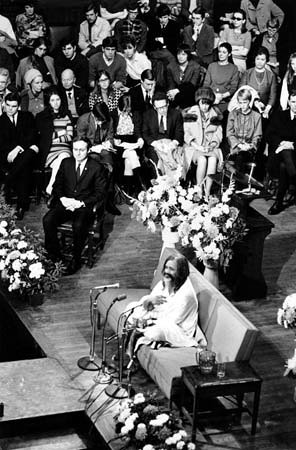
In 1959 the Maharishi lectured and taught the Transcendental Meditation technique throughout America. He spoke at Harvard and came back to Boston area several times later. In 2001 his followers incorporated their own town, Maharishi Vedic City, a few miles north of Fairfield, Iowa along with Maharishi University of Management.

The Commonwealth Avenue in Boston hosts the ‘Hare Krishna’ or ISKCON temple where bhajan and kirtan is performed daily. At the age of 70, founder of ISKCON Srila AC Bhaktivedanta Prabhupada arrived in at the Commonwealth Pier of Boston on September 17, 1965 and bringing ‘Bhakti Yoga’ to America. The ship had a stopover in Boston on the way to New York and he had to complete the immigration requirements. The captain of the ship walked across the foot bridge along with Prabhupada to do some shopping in the nearby area surrounded by bustling shops, offices, churches, clubs and restaurants. Though the stay was short this time, started here a journey of spreading devotion to Lord Krishna globally. It is not known if he publicly chanted at the Commonwealth Pier, but once he reached Lower East side of New York, he started singing. It took few years to have the first ISKCON temple established in neighboring Alston in 1968 in Boston area. After a few years, the community moved to a brownstone building at 72 Commonwealth Avenue.

The Interfaith Diwali celebrations at the historic Arlington Street Church.
This Unitarian Arlington Street Church in Boston is a historic one. It so happened Thoreau and Emerson both were Unitarians. Swami Vivekannda was most welcomed by this church everywhere in America, while some others turned him away. From the pulpit of this very church some of the greatest Indian personalities said to have spoken: Swami Vivekananda, Pramhansa Yogananda, Nobel Laureate Rabindranath Thakur and Srila Prabhupada. So, this year’s celebration of Diwali at this church connected the Bostonians with the past, and created a new history. This year Diwali was celebrated in Boston area which was lead by Amit Dixit of SAAC. The devotees from ISKCON offered kirtan. The event was graced by Swami Tyagananda Maharaj, Rev. Kim Crawford Harvie, Lama Surya Das, Father Alex Oneto and Rabbi Richard Winer.
It started with a celebration at the Massachusetts State House in Boston.
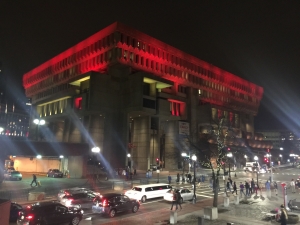
Boston city Hall was lit for the first time in history on the occasion of Diwali.
City of Cambridge, where both MIT and Harvard are located also celebrated Diwali this year in the City Hall. (Photos: Geetha Patil)

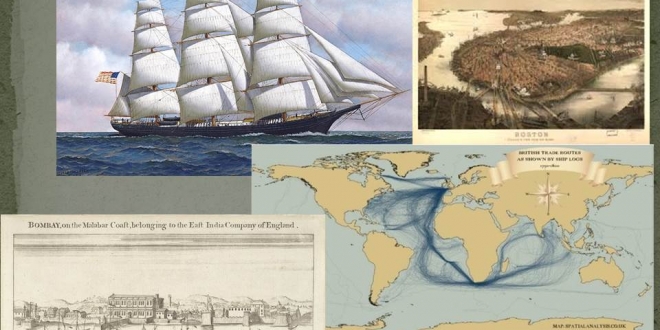
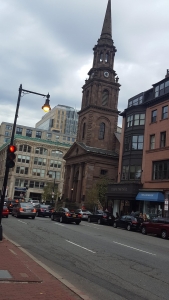
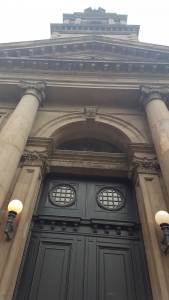


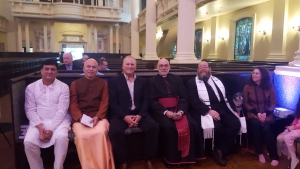


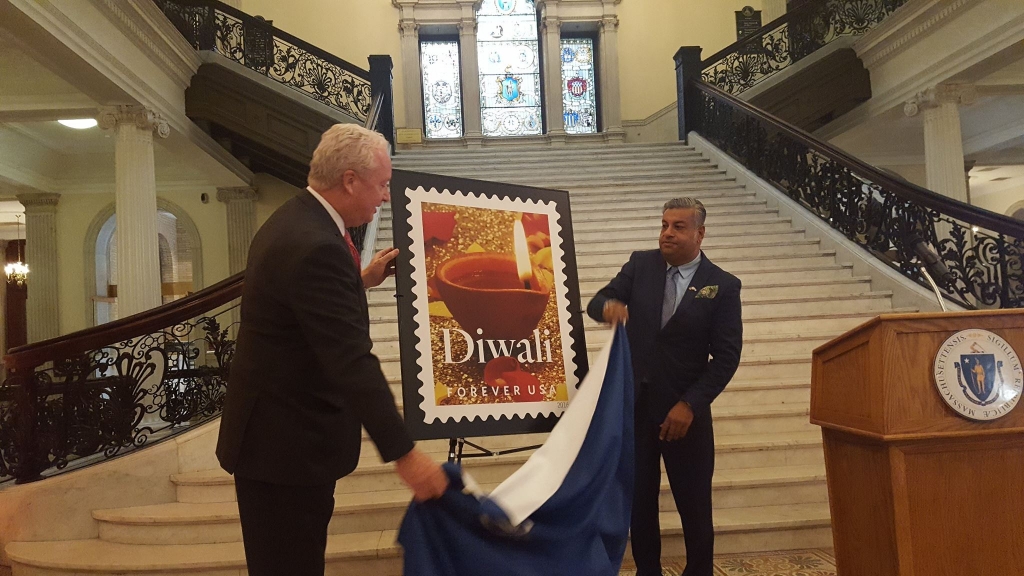
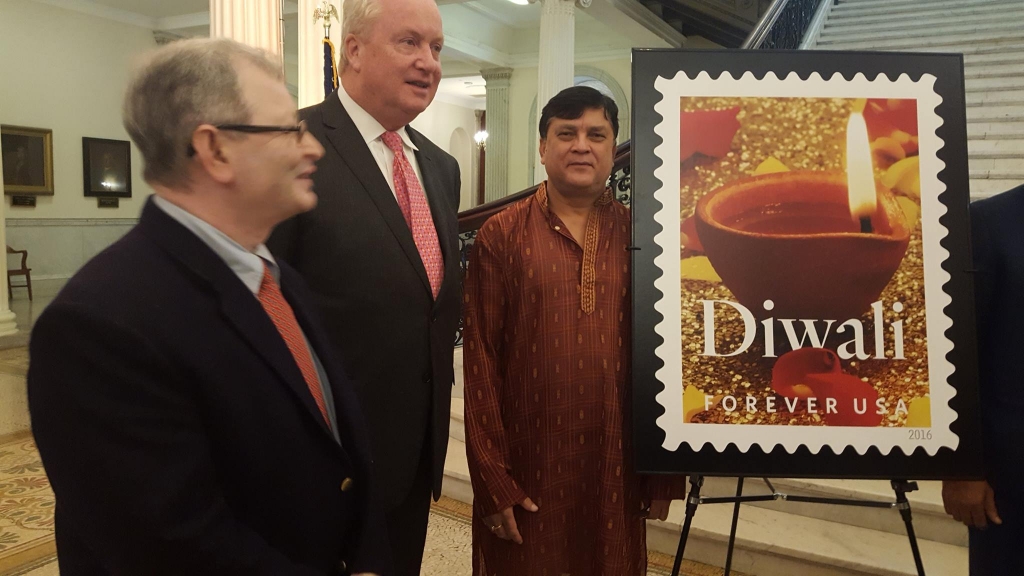
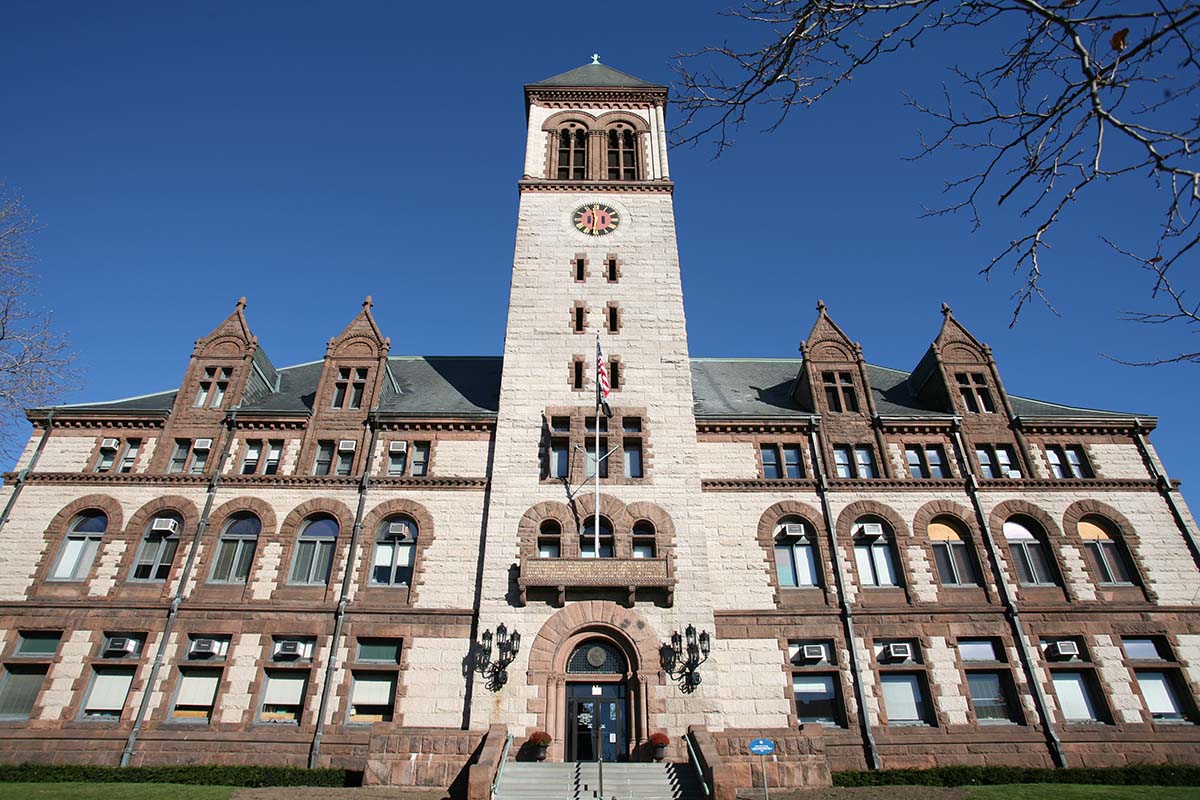
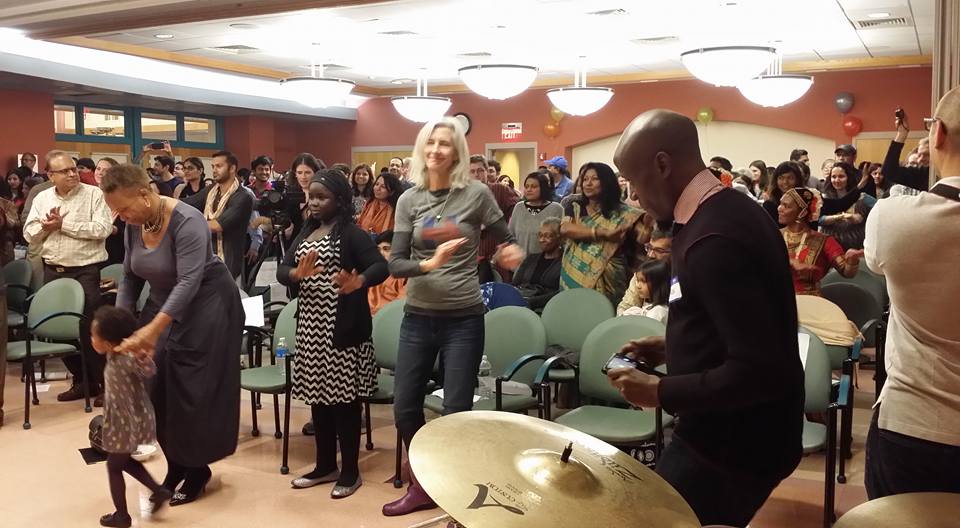
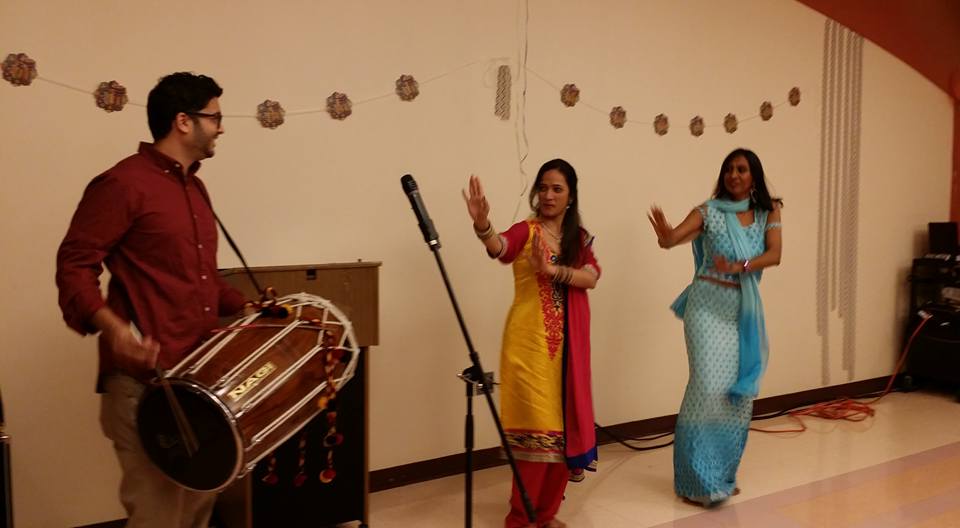





4 Comments
Bhaskar Chakravorti
Very enlightening article with pictures about Bharat and Boston. Thanks
HHari om uttam
Very nice article…..great….history….Congratulation mr /mrs banerjee…
Dr Partha Ghosal
Haimanti…, Very attractive and informative article…. Wonderful pictures and Correlations…
Ved Chaudhary
This is an eye opening article. What a remarkable piece of historical research and investigation that shows how Boston has been a point of confluence (and dharmic or Karmic influence) of so many luminous minds and souls from Bharat. You have done a great service compiling all this information in one neat article. Thank you.